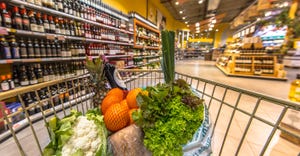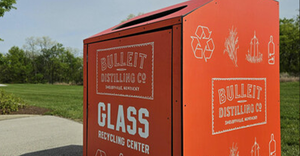Where the Grass is Greener 6450
A well-designed vegetative intermediate landfill cover will bear cost-saving fruit.
April 1, 2010
Dave Hildreth
If you knew that maintaining properly implemented vegetative intermediate landfill covers would only cost you about $25,000 annually, and that fixing a slipshod vegetation program could cost about $200,000 annually, would you would follow an effective vegetation program from the beginning? Unfortunately, successful landfill vegetation can be taken for granted.
The purpose of proper vegetative cover is to help prevent slope erosion, minimize water percolation into the landfill, promote run-off and help control sedimentation. Intermediate covers are placed over areas of the landfill that will be dormant for an extended period of time.
The domino effect of an inadequate vegetative cover can be considerable. It leads to erosion that adds to the sediment. It also opens the surface to water infiltration, which creates more leachate. Runoff over exposed waste in an erosion rill risks contamination of surface water. Poorly built vegetative covers allow gas to escape, causing odors and environmental violations, and they create aesthetic blights.
You don't need to be a professional gardener to accomplish a quality vegetation job at a landfill. What you do need is a plan and standards of practice. Each site will have a unique approach to creating vegetative covers based on geography and climate, but certain elements are standard.
Soil-Seed-Saturation
A landfill using good soil management practices typically segregates the topsoil at the site from the rest of the soils and sets it aside for use as final cover. Topsoil with the needed growing qualities (nutrients, texture, pH balance, etc.) usually is limited to the first 18 inches to two feet of soil. Some areas of the country have greater amounts of topsoil, some significantly less.
Throughout its life, a landfill also needs enough soil to use as intermediate cover on interior slopes, on partially filled areas awaiting additional lifts, and on some outer slopes that develop and build over time. The amount of topsoil available at the typical landfill is not enough to meet this need. Therefore, soil must be taken from new cells or borrow areas. A borrow pit usually is about 20 feet to 50 feet deep, and the soils in it are usually very low in nutrients and difficult to establish vegetation in.
Establishing vegetation in topsoil is relatively easy. Growing vegetation and establishing slope stability with the "dead soils" using in intermediate covers presents a greater challenge and a greater expense.
Stabilizing a slope means establishing proper grades to promote run off, installing proper run-off control features (ditches, berms and down drains) to channel water to an outfall, controlling erosion to keep sediment out of ditches and sediment ponds, and, especially, establishing vegetation.
Major expenditures can be required to re-cover and patch areas of the site with more intermediate soil if they are not stabilized. Such projects take time and manpower away from the other critical daily tasks at the landfill.
Some common mistakes that result in unsuccessful vegetation are:
Waiting until there are more acres needing vegetation than you can manage.
Poor soil preparation before planting (no testing, no pH adjustments, lack of fertilizer or the wrong kind, and burning the seed).
Planting too late in the season.
Using exotic seed mixtures instead of local grasses.
Using cheap seed mixtures. Use a mixture with a Pure Live Seed (PLS) rating of at least 90 percent. In seed mixtures with a lower rating, many of the seeds will not germinate; rather, they will simply compete with other seed for the nutrients from the soil, and both will die off.
No run-off control, resulting in grass being lost in the first good rain and erosion that requires expensive repairs.
Just calling a local landscaper and taking your chances with someone else's "guarantee."
Establish intermediate vegetative cover in the first growing season on all areas in view of the public. This helps to establish your site as a good neighbor. Also, grow intermediate vegetative covers on interior areas that will remain dormant for one year and stockpiles of soil that will remain dormant for more than one year.
The proper planting season varies according to the area of the country. In general, don't seed between Oct. 15 and March 15. Study rainfall, soil conditions, temperatures and local conditions to determine the proper planting season. Check the local 10-day weather forecast before seeding, as heavy rains can wash away freshly applied seed and fertilizer.
Before seeding, test the soil to determine the types of fertilizers, limes or nutrients that will be needed. Evaluating the soil before applying vegetation will lower costs and increase the probability of success. Work the soil by grading and disking to the proper texture for seeding.
Seed selection and fertilizers are both important to establish sound intermediate vegetation. Use native grasses for intermediate areas because they have a better chance of growing and surviving in local conditions. Get advice from the local extension agent or highway department before selecting the best component mixtures.
All slopes that receive vegetative cover must have surface water-control measures to prevent erosion and control sediment. Construct berms on the top of the slopes to minimize drainage. Construct down drains to channel run-off to drain structures at the bottom of slopes. Consult an engineer to make sure the design addresses the needs of the site and complies with permits.
Other erosion-reducing methods include use of hay bales, silt fences, horizontal diversion berms and mulch mats. Matting placed over the seed areas can add considerable cost. Blown crimped straw can cost less than matting but both often are passed over because of the expense. However, the value of these products is that they increase moisture retention to aid seed germination. Along with the reduced risk of erosion, they pay for themselves. The re-work is what is really expensive.
Some climates require regular watering to establish vegetation. In other climates, if seeding is done at the correct time of the year, natural precipitation will be adequate.
If additional watering is necessary, use an irrigation system. Portable sprinkler or irrigation systems can be cost-effective unless they're too small for the area you've planted. If they are too small, you'll waste time and water, and your vegetation will not take. It's better to oversize your watering system and run it for shorter periods.
The source of water often can be as critical as the quantity. Test the water supply beforehand to make sure it is appropriate for vegetative growth. Using high-saline water may saturate the soil with salts and kill the vegetation.
Mow the seeded area regularly (at least quarterly), and let the cuttings lay to provide additional mulch and water storage. Continuously monitor the slopes for erosion, and apply fertilizer and lime periodically to help thicken the grass.
When it comes to vegetative covers, it definitely pays to get it right the first time.
Dave Hildreth is the senior manager of operations support for Phoenix-based Republic Services.
Related Stories
You May Also Like


